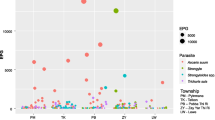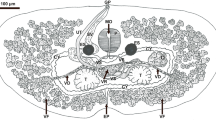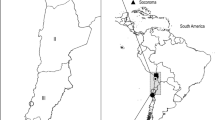Abstract
Postharmostomum commutatum (Dietz, 1858), a parasite of the caeca of poultry, has been reported from many different parts of the world. Despite its importance, there are no molecular sequences available and its phylogenetic position is unknown in relation to other members of Brachylaimoidea, a group in which taxonomic confusion reigns. Here, morphological and molecular techniques were used to study digeneans from the caeca of free-range chickens found naturally infected in the municipality of Viçosa, state of Minas Gerais, Brazil, between August 2017 and May 2018. The specimens were identified as P. commutatum, with Postharmostomum gallinum Witenberg, 1923 herein considered a junior synonym. Sequences obtained for the 28S, ITS2, and cox-1 genes were compared with sequences available from other species of Brachylaimoidea. Phylogenetic analysis of the three markers indicates P. commutatum formed an isolated lineage from other brachylaimoids, supporting the distinct status of the genus. The topology of phylogenetic trees obtained suggests that the morphology-based classification of families of Brachylaimoidea is artificial and new rearrangements of some genera or creation of new families may be necessary. The sequences newly obtained here will be useful for testing the cosmopolitan distribution of P. commutatum.


Similar content being viewed by others
References
Alicata JE (1940) The life cycle of Postharmostomum gallinum the cecal fluke of poultry. J Parasitol 26:135–143
Alicata JE (1964) Parasitic infections of man and animals in Hawaii. Tech Bull Hawaii Agric Exp Sta 6:11–139
Amato SB, Bezerra JC (1992) Concurrent infection of Postharmostomum gallinum (Digenea, Brachylaimidae) and Eurytrema coelomaticum (Digenea, Dicrocoeliidae) in Bradybaena similaris (Stylommatophora, Xanthonichidae). Mem Inst Oswaldo Cruz 87:309–311
Blasco-Costa I, Cutmore SC, Miller TL, Nolan MJ (2016a) Molecular approaches to trematode systematics: ‘best practice’ and implications for future study. Syst Parasitol 93:295–306
Blasco-Costa I, Poulin R, Presswell B (2016b) Species of Apatemon Szidat, 1928 and Australapatemon Sudarikov, 1959 (Trematoda: Strigeidae) from New Zealand: linking and characterising life cycle stages with morphology and molecules. Parasitol Res 115:271–289
Bowles J, Blair D, McManus DP (1995) A molecular phylogeny of the human schistosomes. Mol Phylogenet Evol 4:103–109
Brant SV, Morgan JA, Mkoji GM, Snyder SD, Rajapakse RP, Loker ES (2006) An approach to revealing blood fluke life cycles, taxonomy, and diversity: provision of key reference data including DNA sequence from single life cycle stages. J Parasitol 92:77–88
Casey SP, Bakke TA, Harris PD, Cable J (2003) Use of ITS rDNA for discrimination of European green- and brown-banded sporocysts within the genus Leucochloridium Carus, 1835 (Digenea: Leucochloriidae). Syst Parasitol 56:163–168
Cowie RH, Hayes KA, Tran CT, Meyer MM III (2008) The horticultural industry as a vector of alien snails and slugs: widespread invasions in Hawaii. Int J Pest Manag 54:267–276
Dawes B (1968) The Trematoda with special reference to British and other European forms. Cambridge University Press, London
Deiana S, Arru E (1963) II ciclo biologico di Postharmostomum commutatum (Dies, 1858) ricostruito sperimentalmente in Sardegna. Riv Parassitol 24:163–177
Diesing KM (1858) Revision der Myzhelminthen. Abtheilung:Trematoden. S B Akad Wiss Wien 32:307–390
Dollfus RP (1935) Sur quelques Brachylaemus de la faune française récoltés principalement a Richelieu (Indre et Loire). Ann Parasitol Hum Comp 13:52–79
Duarte MJF (1980) The life cycle of Postharmostomum gallinum Witenberg, 1923, in Rio de Janeiro state, Brazil. Rev Bras Biol 40:793–809
Fernandes B, Justo C, Cárdenas M, Cohen S (2015) South American trematodes parasites of birds and mammals. FIOCRUZ – RJ, Rio de Janeiro
Heneberg P, Sitko J, Bizos J (2016) Molecular and comparative morphological analysis of central European parasitic flatworms of the superfamily Brachylaimoidea Allison, 1943 (Trematoda: Plagiorchiida). Parasitology 143:455–474
Hernández-Mena DI, García-Varela M, Pérez-Ponce de León G (2017) Filling the gaps in the classification of the Digenea Carus, 1863: systematic position of the Proterodiplostomidae Dubois, 1936 within the superfamily Diplostomoidea Poirier, 1886, inferred from nuclear and mitochondrial DNA sequences. Syst Parasitol 94:833–848
Iwaki T, Okamoto M, Nakamori J (2006) Urogonimus macrostomus (Digenea: Leucochloridiidae) from the rustic bunting, Emberiza rustica, in Japan. Parasitol Int 58:303–305
Joyeux C, Houdemer E (1928) Recherches sur la faune helminthologique d l’Indochine (cestodes et trématodes). Ann Parasitol Hum Comp 6:27–58
Joyeux C, Baer JG, Timon-David J (1934) Recherches sur les trematodes du genre Brachylaemus Dujardin (syn. Harmostomum Braun). Bull Biol Fr Belg 68:385–418
Katoh K, Standley DM (2013) MAFFT multiple sequence alignment software version 7: improvements in performance and usability. Mol Biol Evol 30:772–780
Kumar S, Stecher G, Tamura K (2016) MEGA7: molecular evolutionary genetics analysis version 7.0 for bigger datasets. Mol Biol Evol 33:1870–1874
Locke SA, Lapierre AR, Byers K, Proctor H, McLaughlin JD, Marcogliese DJ (2012) Molecular and morphological evidence for the Holarctic distribution of Urogonimus macrostomus (Rudolphi, 1803) Monticelli, 1888 (Digenea: Leucochloridiidae). J Parasitol 98:880–882
Locke SA, Van Dam AR, Caffara M, Pinto HA, López-Hernández D, Blanar C (2018) Validity of the Diplostomoidea and Diplostomida (Digenea, Platyhelminthes) upheld in phylogenomic analysis. Int J Parasitol. https://doi.org/10.1016/j.ijpara.2018.07.001
Miao YW, Peng MS, Wu GS, Ouyang YN, Yang ZY, Yu N, Liang JP, Pianchou G, Beja-Pereira A, Mitra B, Palanichamy MG, Baig M, Chaudhuri TK, Shen YY, Kong QP, Murphy RW, Yao YG, Zhang YP (2013) Chicken domestication: an updated perspective based on mitochondrial genomes. Heredity 110:277–282
Miura O, Kuris AM, Torchin ME, Hechinger RF, Dunham EJ, Chiba S (2005) Molecular-genetic analyses reveal cryptic species of trematodes in the intertidal gastropod, Batillaria cumingi (Crosse). Int J Parasitol 35:793–801
Nakao M, Anders JL, Asakawa M, Koga D, Sasaki M, Waki T (2017) Brachylaima ezohelicis sp. nov. (Trematoda: Brachylaimidae) found from the land snail Ezohelix gainesi, with a note of an unidentified Brachylaima species in Hokkaido, Japan. Parasitol Int 66:240–249
Nakao M, Anders JL, Katahira H, Sasaki M, Waki T (2018) Brachylaima asakawai sp. nov. (Trematoda: Brachylaimidae), a rodent intestinal fluke in Hokkaido, Japan, with a finding of the first and second intermediate hosts. Parasitol Int 67:565–574
Olson PD, Cribb TH, Tkach VV, Bray RA, Littlewood DT (2003) Phylogeny and classification of the Digenea (Platyhelminthes: Trematoda). Int J Parasitol 33:733–755
Paithankar KR, Prasad KSN (1991) Precipitation of DNA by polyethylene glycol and ethanol. Nucleic Acids Res 19:1346–1346
Pence DB (1994) Postharmostomiasis in wild turkeys in New Mexico. J Wildl Dis 30:285–286
Penn O, Privman E, Ashkenazy H, Landan G, Graur D, Pupko T (2010) GUIDANCE: a web server for assessing alignment confidence scores. Nucleic Acids Res 38:23–28
Pereira C, Cuocolo R (1939) A propósito de Postharmostomum commutatum. Arq Inst Biol (São Paulo) 10:73–88
Pojmańska T (2002) Family Brachylaimidae Joyeux & Foley 1930. In: Gibson DI, Jones A, Bray RA (eds) Keys to the Trematoda, Ed. CABI, London, pp 37–43
Ronquist F, Teslenko M, van der Mark P, Ayres DL, Darling A, Höhna S, Larget B, Liu L, Suchard MA, Huelsenbeck JP (2012) MrBayes 3.2: efficient Bayesian phylogenetic inference and model choice across a large model space. Syst Biol 61:539–542
Silva GS, Romera DM, Fonseca LEC, Meireles MV (2016) Helminthic parasites of chickens (Gallus domesticus) in different regions of São Paulo State, Brazil. Rev Bras Cienc Avic 18:163–168
Sinitsin D (1931) Studien uber die phylogenie der trematoden, V: revision of Harmostominae in the light on new facts from their morphology and life history. Z Parasitenkd 3:785–835
Soulsby EJL (1982) Helminths, arthropods and protozoa of domesticated animals, 7th edn. Baillière Tindall, London
Taylor MA, Coop RL, Wall RL (2016) Veterinary parasitology. Fourth edition. Chichester, West Sussex; Ames, Iowa: John Wiley and Sons, Inc., England
Tkach VV, Littlewood DTJ, Olson PD, Kinsella JM, Swiderski Z (2003) Molecular phylogenetic analysis of the Microphalloidea Ward, 1901 (Trematoda: Digenea). Syst Parasitol 56:1–15
Travassos L, Freitas JFT, Kohn A (1969) Trematódeos do Brasil. Mem Inst Oswaldo Cruz 67:1–886
Wagener GR (1852) Enthelminthiea, n. III. Archiv Anat Physiol:555–567
Witenberg G (1923) Harmostominae in Skryabin K. I. [Trematodes of domestic birds]. Arb Inst Exp Vet Moscow 2:193–256
Witenberg G (1925) Versuch ether Monographie der Trematoden Unterfamilie Harmostominae Braun. Zool Jahrb Abt Anat Ontog Tiere 51:167–254
Xiang H, Gao J, Yu B, Zhou H, Cai D, Zhang Y, Zhao X (2014) Early Holocene chicken domestication in northern China. Proc Natl Acad Sci U S A 111:17564–17569
Yamaguti S (1971) Synopsis of digenetic trematodes of vertebrates, vol I, II. Publishing Co, Japan
Yamaguti S (1975) A synoptical review of life histories of digenetic trematodes of vertebrates with special reference to the morphology of their larval forms. Keigaku Publishing Co, Japan
Ždarska Z, Soboleva TN (1983) Electron microscope observations on the sporocyst of Postharmostomum gallinum Witenberg, 1923 (Brachylaimidae). Folia Parasitol 32:227–230
Acknowledgements
The authors are very grateful to two anonymous reviewers for their careful and constructive suggestions that substantively improved the manuscript.
Funding
This work was financially supported by the National Council for the Improvement of Higher Education (CAPES) (scholarship to MCV and DLH) and the Fundação de Amparo à Pesquisa do Estado de Minas Gerais (FAPEMIG) (scholarship to BCMS).
Author information
Authors and Affiliations
Corresponding author
Ethics declarations
The use of parasites from chickens was in accordance with local animal research ethics committees of Universidade Federal de Viçosa (protocol CEUA/UFV 69/2017).
Conflicts of interest
The authors declare that they have no conflict of interest.
Additional information
Section Editor: Christoph G. Grevelding
Rights and permissions
About this article
Cite this article
Valadão, M.C., Silva, B.C.M., López-Hernández, D. et al. A molecular phylogenetic study of the caecal fluke of poultry, Postharmostomum commutatum (= P. gallinum) (Trematoda: Brachylaimidae). Parasitol Res 117, 3927–3934 (2018). https://doi.org/10.1007/s00436-018-6102-5
Received:
Accepted:
Published:
Issue Date:
DOI: https://doi.org/10.1007/s00436-018-6102-5




